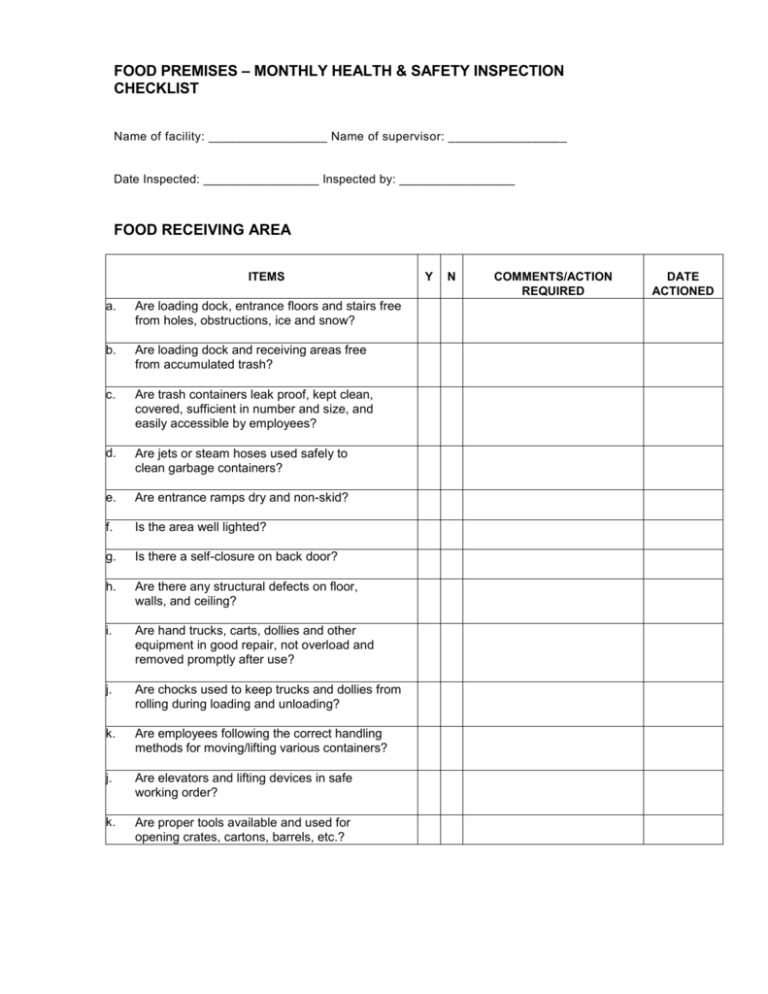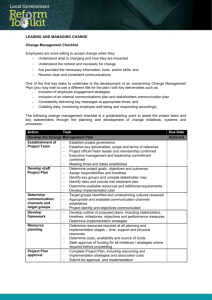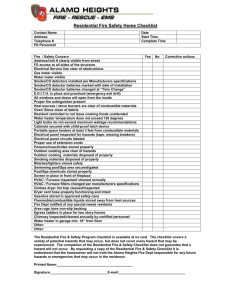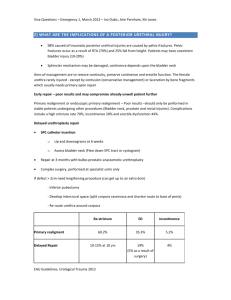food premises * monthly health & safety inspection checklist
advertisement

FOOD PREMISES – MONTHLY HEALTH & SAFETY INSPECTION CHECKLIST Name of facility: _________________ Name of supervisor: _________________ Date Inspected: _________________ Inspected by: _________________ FOOD RECEIVING AREA ITEMS a. Are loading dock, entrance floors and stairs free from holes, obstructions, ice and snow? b. Are loading dock and receiving areas free from accumulated trash? c. Are trash containers leak proof, kept clean, covered, sufficient in number and size, and easily accessible by employees? d. Are jets or steam hoses used safely to clean garbage containers? e. Are entrance ramps dry and non-skid? f. Is the area well lighted? g. Is there a self-closure on back door? h. Are there any structural defects on floor, walls, and ceiling? i. Are hand trucks, carts, dollies and other equipment in good repair, not overload and removed promptly after use? j. Are chocks used to keep trucks and dollies from rolling during loading and unloading? k. Are employees following the correct handling methods for moving/lifting various containers? j. Are elevators and lifting devices in safe working order? k. Are proper tools available and used for opening crates, cartons, barrels, etc.? Y N COMMENTS/ACTION REQUIRED DATE ACTIONED ITEMS l. Y N COMMENTS/ACTION REQUIRED DATE ACTIONED Y N COMMENTS/ACTION REQUIRED DATE ACTIONED Are crate, carton and barrel opening done away from open containers of food? m. Are shipping cartons intact? FOOD PROCESSING AREA ITEMS a. Are cold foods maintained below 7°C (45°F) during meal preparation (thermometers used)? b. Are hot foods maintained at a minimum of 60°C (140°F) during meal preparation (thermometers used)? c. Are frozen foods pulled from freezer the day before use and place in a refrigerator for thawing? d. Is cold running water used to thaw products in production sinks (thermometers used)? e. Are production sinks cleaned and sanitized between products, as well as before use? f. Are non-slip mats used under cutting boards? g. Are all food contact surfaces, and cutting boards cleaned and sanitized when changing from raw product to cooked food and after use? h. Are icemakers free of mould growth? i. Is frying oil filtered and rotated? j. Are fryers surfaces, and area between and beneath fryers cleaned frequently to prevent particle build-up? k. Are hoods free of oil drips and dust build-up? l. Are non-flammable solvents or cleaning acids used for hoods, fans, ducts, and grease removal devices? m. Are production shelves and racks clean and well maintained? n. Is electrical equipment properly grounded, guarded and inspected regularly by an electrician? o. Are pieces of equipment switched off before adding ingredients, removing products, or cleaning? p. Are the switches located so that they can be reached readily in the event of an emergency? q. Is all equipment and utensils in good repair, (not broken, chipped, cracked) and performing satisfactorily? r. Are wiping cloths stored in sanitizing solution? s. Are floors clean, dry, free of spills, and adequately maintained (mopped daily and covered with non-skid surface where necessary and are defective tiles replaced)? t. Do employees pick up or clean up all dropped items and spillage? u. Are electrical switches located to avoid employees contacting metal equipment when using them? v. Are employees instructed on the proper operation and hazards of machines? w. Are only authorized and trained employees operating equipment? x. Is a pusher or tamper provided for use with the grinders? y. Are mixers in safe operating condition? z. Are the mixer beaters properly maintained to avoid injury from broken metal parts and foreign particles in food? aa. Is a First Aid kit readily accessible and clearly marked for emergency use? bb. Does first aid kit meet the quantity and quality requirements? 13-O-2-3/15 August 2006 cc. Are all accidents and injuries reported immediately to supervisor? dd. Are portable signs used to indicate wet floors or other temporary hazards? ee. Were the microwave ovens inspected (technically) by P Med Tech during the past year? ff. Are microwave ovens clean, in good repair, especially doors and seals? gg. Is the ventilation adequate, screened windows and doors, designed to prevent back flow of contaminants from vents or hoods onto the food or food preparation surfaces? hh. Is lighting system clean and adequate? ii. jj. Are empty containers removed promptly from the area? Are filters over fryers cleaned regularly and free of accumulated grease? kk. Are knives being properly used, stored and sharpened? ll. Are employees using potholders for handling pots and pans? mm. Are handles of pans in use not protruding into aisle space? nn. Are handles of cooking utensils tight? oo. Are can opener blades clean and in good repair? pp. Have employees been trained in a “double check” system to ensure all cooking equipment is turned off when preparing to close? qq. Are pieces of equipment turned off when not in use or unattended? rr. Are garbage containers kept covered when not in use? 13-O-2-4/15 August 2006 SERVING AND DINING AREAS ITEMS a. Are steam tables cleaned daily and regularly maintained? b. Is safety valve equipment operative? c. Are serving counters, tables, carts, and chairs free of broken parts and wooden or metal slivers and burrs? d. Is the equipment free from sharp corners? e. Is other serving equipment in good condition? f. Are there regular inspections of: glassware, china, cutlery, plastic, and equipment? g. Are hot liquids and serving containers, steam and heat lamps handled safely? h. Is proper syrup to carbonated water ratios maintained on soda dispensers by using test kit? i. Are soda nozzles and the area around the nozzles washed daily? j. Are condiment pumps taken apart and cleaned daily? Is a brush available for cleaning? k. Are utensils stored with the handles up? l. Are dirty glassware returned to dish, not placed in racks with clean glasses? Y N COMMENTS/ACTION REQUIRED DATE ACTIONED m. Are customers guarded from hot food holding equipment? n. Are tray rails adequate and set to prevent trays from slipping or falling off at the end or the corners? o. Are floors kept clean and in good repair (covered with non-skid material and free from broken tiles)? p. Are floors policed for immediate cleaning up spillage or other materials? 13-O-2-5/15 August 2006 ITEMS Y N COMMENTS/ACTION REQUIRED DATE ACTIONED Y N COMMENTS/ACTION REQUIRED DATE ACTIONED q. Are portable signs used to indicate wet floors or other temporary hazards? r. Is the traffic flow set so that patrons or workers do not collide while carrying trays or obtaining food? s. Are trays and carts overloaded? t. Are the doors to and from the serving area clearly marked? u. Is lighting system cleaned and adequate? v. Are air vents kept clean? w. Are tray stands and service carts in good repair and not obstructing traffic? x. Are workers refraining from overloading trays or bus pans? y. Are broken, wobbly, or unsteady chairs and tables quickly repaired? z. Is electrical equipment properly grounded? aa. Are evacuation routes posted? DISHWASING AREA ITEMS a. Is all plumbing in good repair? b. Is the following dishwashing method applied: Pre-washing or scraping Washing water 49 to 60°C (120 to 140°F)? Rinsing water at a minimum 82°C (180°F)? c. Are rinse jets, wash arms, curtains, etc. in place and in good condition? d. Are cleaning compounds and drying agents used correctly? ITEMS Y N COMMENTS/ACTION REQUIRED DATE ACTIONED e. Are detergents, drying agents and sanitizers stored away from food and separate from other chemicals? f. Is following manual washing procedure applied: Pre-washing or scraping Use 3 compartment sink Wash in 1st sink, detergent and water at minimum temperature of 44°C (110°F) Rinse in 2nd sink with clear water at minimum temperature of 44°C (110°F) Sterilize in 3rd sink with clear water at a minimum temperature of 82°C (180°F), or immerse utensils for at least 2 minutes in water solution with not less than 100PPM of available chlorine g. Are dishes and silverware properly racked? h. Is a broken glass container available, labelled and used only for that purpose? i. Are floors reasonably free of excessive water and spillage? j. Are floor tiles properly maintained and in safe condition (free from worn and broken areas)? k. l. Are all electrical units properly grounded? Are switches located to permit rapid shutdown in the event of an emergency? m. Are adequate rubber gloves provided? n. Are dish racks in safe condition (if metal, are they free of sharp corners that could cause cuts)? o. Are these racks kept off the floor to prevent tripping? p. Is there an adequate drain board or other drying area so that employees do not have to pile pots and pans on the floor before and after washing them? q. If dishes are removed on portable racks or bus trucks, are these units in safe operating condition? 13-O-2-7/15 August 2006 ITEMS r. s. Y N Y N COMMENTS/ACTION REQUIRED DATE ACTIONED Is lighting/ventilation adequate? Are knives and cutting blades left unattended in filled sinks? REFRIGERATED STORAGE ITEMS a. Are all food products rotated (first in, first out)? b. Are all food products in closed containers – no open foods? c. Are leftover foods dated for rotation? d. Are blower fans clean and guarded? e. Are emergency door latches in good working condition? f. Is there adequate ventilation? g. Is lighting adequate and properly shielded? h. Are door gaskets and sweeps clean and in good repair? i. Are floors clean and free of ice – under storage, racks? j. Are portable storage racks and stationary racks in safe condition (free from broken and bent shelves and set on solid legs)? k. Is there a by-pass system on the door to permit exit if an employee is locked in? l. Are heavy items stored on lower shelves and lighter items on higher shelves? m. Are shelves adequately spaced to prevent pinched hands? COMMENTS/ACTION REQUIRED DATE ACTIONED DRY STORAGE AREA ITEMS a. Are aisles and floors free of boxes and cartons, clean and dry? b. Any structural defects on floor, ceiling and walls? c. Are heavier items stored on pallets or shelves near the floor at least 15cms (6”) from the floor? d. Are items cross-stacked to avoid tripping or tumbling? e. Are shelves items easy accessible and supporting items stored safely? f. Are step stools or ladders used to reach shelved items above shoulder level? g. Are all food products rotated (check code dates and discard inactive products)? h. Are all food products in closed containers – no open foods? i. Are cartons stored away from wetness or dampness, which would cause their collapse? j. Are proper tools for opening crates, boxes, barrels and other containers provided and used? k. Is soda storage (soft drink) area clean? l. Are all compressed air cylinders (soft drink) secured or chained? Y N COMMENTS/ACTION REQUIRED DATE ACTIONED m. Are all chemicals, solvents, caustics, pesticides, etc, labelled, tightly covered and properly stored away from food? n. Is lighting system adequate, clean and guarded fixtures? o. Is there a fire extinguisher located at the door? p. Is the ventilation system clean and adequate? q. Are broken items promptly and safely swept up/discarded? 13-O-2-9/15 August 2006 RESTROOMS (WASHROOMS, LUNCHROOMS, LOCKER ROOMS) ITEMS a. Is floor in washroom clean, and free from hazardous soap or wetness accumulation? b. Is facility free of trash, debris, and food spillage? c. Are lights and electrical equipment operating satisfactorily? d. Is floor free from glassware, dishware or other items, which could cause trips and falls? e. Are tops of lockers free of glassware, dishware and heavy objects? f. Y N COMMENTS/ACTION REQUIRED DATE ACTIONED Y N COMMENTS/ACTION REQUIRED DATE ACTIONED Are safe receptacles provided for areas where smoking is permitted? g. Is all furniture and equipment in good repair? h. Are lockers secured to floor or wall? OUTDOOR AREA ITEMS a. Are walks, steps, ramps, and other passageways in good repair and free from holes or obstructions? b. Are parking lots well marked to indicate entrances, exits and traffic patterns? c. Is the area free from carts, boxes, cans, and debris, which could constitute a hazard? d. Are exterior platforms, steps, and parking areas well lit at night during operational hours? e. f. Are trash and other combustibles kept away from the building? Are bottled gas cylinders properly supported and protected from physical damage? g. Is ice and snow sanded, or removed promptly from exterior landings, steps, walks, passageways, and parking areas? h. Are parking lots free of holes that could cause tripping and injury? i. Are hanging signs, awnings, and other exterior accessories safely secured? EMPLOYEES – FOOD PREMISES ITEMS a. Did the employees receive job orientation training, basic WHMIS, Job specific health and safety hazards associated with their duties and related equipment? b. Do employees understand the basic principles and their responsibilities as outlined within the CFPSA/ NPF’s Occupational Health and Safety policy? c. Are employees instructed, counselled and reminded through safety meetings, on-thejob safety training, posters or newsletters? d. Is there an OHS Bulletin Board providing names of WOHSC members, minutes form meetings, a copy of Canada Labour Code Part II, etc? e. Are employees showing signs and symptoms of cold, skin rash, finger cuts, etc, removed from primary food handling duties until approval obtained from a medical officer? f. Are employees properly reporting all accidents or illnesses? Y N COMMENTS/ACTION REQUIRED DATE ACTIO NED g. Are employees encouraged to report hazards and suggest safety improvements? h. Are employees using machine guards, plungers, and other safety devices in operating cutting machines and cooking equipment? i. Are employees who are doing heavy lifting accomplishing it in the proper manner? j. Do employees abstain from using boxes or chairs to reach higher shelves? k. Do employees refrain from putting knives or other sharp objects in sinks? l. How many employees have valid fist aid and CPR certificates? m. How many employees have “Smart Serve” or equivalent certifications? n. How many employees have “National Food Safety Certificate” or equivalent certifications? o. Is the food premise operating with at least one employee holding a valid food safety-training certificate at all times? p. Are employees’ clothing stored separated from food products? q. Is employee clothing free of raggedness and looseness which could be hazardous around moving equipment? r. Are employees wearing suitable, low heeled, shoes, which minimize slipping, or falling? s. Are employees prohibited from wearing loose or dangling jewellery near moving equipment or food? t. Are employees with long hair wearing adequate hair restraints to prevent risk of entanglement? u. Have employees been trained to use fire extinguishers? GENERAL OBSERVATION – FOOD PREMISES ITEMS a. Are stairways clean, in good repair and solid to the step? b. Are there loose tread pads, runners or nonskid strips? c. Are railings in good repair, free of splinters, and solid? d. Is stairway free of any obstacles such as trash, boxes, mops, and brooms? e. Is stairwell provided with adequate natural light or well illuminated? f. Are floors at the base of stairs clear, clean, dry, and free from holes or other hazards? g. Are ladders and step stools solid, in good repair and properly stored? h. Are metal ladders free from rough or sharp edges? i. Are ladders equipped with non-skid feet or tips? j. Are slip resistant waxes or polishes used in treating floors? k. Are floors and aisle ways free from protruding obstacles such as nails, pipe ends, ridges, holes, or broken tiles? l. Are portable signs used to indicate wet moped floors or temporary hazards? m. Are floor mats, wooden duckboards, etc. in good repair? n. Where carpeted, are there holes, tears or loose threads, which could cause tripping? o. Are first aid kits available for emergency use? p. Are the locations marked conspicuously? Y N COMMENTS/ACTION REQUIRED DATE ACTIONED ITEMS q. Are lists of contents posted on or adjacent to the kits? r. Is there an adequate supply of each of the kit components? s. Are the items that deteriorate replaced at required intervals? t. Is at least one employee on each shift trained to give first aid? u. Are the telephone numbers of the fire department and other emergency services readily accessible? v. Are there periodic fire evacuation drills? w. Is the number of building occupants within the listed capacity? x. Are decorations of flameproof or non-combustible materials? y. Are all fire extinguishers properly labelled (class of fire), mounted, inspected regularly, visible and accessible? z. Have the automatic sprinkler systems standby and hose installations been inspected within the last year and are they in operable condition? aa. Has the automatic fire protection system over cooking appliances been inspected and serviced by qualified persons in the last six months? bb. Are extension cords and multiple plugs in good condition and used properly to prevent overloading of circuits? cc. Are extension cords prohibited from use as a substitute for fixed wiring? dd. Are switches for electrical equipment easy to reach (do not have to lean on or touch metal to reach) in the event of an emergency? ee. Are safety switches used to prevent inadvertent or accidental starting? Y N COMMENTS/ACTION REQUIRED DATE ACTIONED ff. Are electrical contacts and receptacles kept free of spattered fat or grease? gg. Is adequate lighting provided at stairs and other hazardous areas? hh. Are sockets and switches in good condition? ii. Is electrical equipment properly grounded? jj. Are covers of fuse and switch boxes kept closed? kk. Are fuses on lighting and small appliances circuits of proper capacity? ll. Are circuits on panel boards properly identified? mm. Are panel boards not obstructed and easily accessible? nn. Are light fixtures over food preparation, service, display, and warehousing areas shielded to protect against breakage? oo. Is there an identifying label on the entrance door? pp. Are the appropriate safety colours used for marking hazards? qq. Is all equipment inspected per schedule, in good repair and working order? rr. Are belts, fans, and other moving parts adequately guarded and all fans and louvers clean? ss. Is the area free from storage of combustible material, broken equipment waiting repairs and surplus supplies? tt. Is machinery securely anchored? uu. Is all heating and cooling equipment including chimneys, gas appliances, flues, smoke pipes and air ducts in good condition and well maintained? vv. Are heat recovery and air quality control devices maintained and cleaned as required? ww. Are filters cleaned and/or changed as scheduled?



